
The morning after we stymied the planned enemy assault on our district headquarters, thanks to the available support of the US Air Force, an assessment of the situation was necessary. The cluster bombs that the A37 Dragonfly had scattered above the enemy force to the south of our compound could be most devastating. Consequently, just after daybreak, the Vietnamese sent out a patrol to recon the previously bombed area just outside our perimeter. As I was on the radio with higher headquarters, I refrained from joining them, awaiting their report upon completion of the patrol. My coordination with headquarters involved preparing for the arrival of elements from the 18th ARVN division, which had been dispatched to counter the province-wide hostile activity of the enemy forces. The majority of the 18th RVN had been dispatched earlier to An Loc to the west of Saigon to counter severe coordinated enemy attacks at that location.
Upon the return of the patrol, I was briefed through my interpreter that while they found no bodies or equipment, there were numerous blood trails and signs of things being dragged away – more than likely enemy corpses. Evidently, they had their own version of “leave no man behind”. I passed this information to higher headquarters and began reviewing written reports that my translator had prepared from Vietnamese Intel documents. These reports confirmed that the enemy had infiltrated several villages and hamlets in my district and the rest of the province. Removing them would take quite an effort, but the increase in friendly troops, who had more experience and were better trained than the Regional and Popular Forces, would make success more likely.
And during this whole adventure, there was this unconscious nagging in the back of my mind, that it was quite possible I wouldn’t be able to take R& R. I couldn’t begin to imagine how traumatic it would be for Jo to arrive in Hawaii trying to link up with her husband and not finding him. The worst part of it was that there was no easy way to even alert her to the possibility that I wouldn’t be there. In theory, I could meander through USO channels or perhaps the Red Cross. However, with more pressing issues at hand I wasn’t able to spend a lot of time on speculation.
As the first elements of the 18th RVN began moving through my district, I was immersed in bilingual coordination to include talking to the 18th ’s US advisor, call sign Buffalo 6. Once the lead elements passed the district compound moving in the direction of the National Police Headquarters (NPHQS), they met heavy resistance, and the advance stalled in place. After some discussion among all the players over radios and through interpreters, Vietnamese air support in the form of A1E Skyraider aircraft arrived.
The ordinance carried was several Mark 82 500-pound bombs. The ground shook and the noise was overwhelming when they hit. Once the bombing runs were completed, the Vietnamese forces slowly moved out and began checking the rubble of what once was an intact village. The logic to justify the destruction of so many homes and buildings was that the US would rebuild them as soon as practical.
The devastation was such that the enemy effort was thwarted in place and they promptly withdrew. Surprisingly, within a few days, things were more or less back to “normal”. Amazingly, the timing was just right. I checked with my boss, the Province Senior Advisor, LTC Giac Modica (who coincidentally had been a first regimental Tactical Officer while we were at school) regarding my R&R, and he authorized me to put the wheels in motion. A few days later, I was on my flight to Hawaii.
Jo had made arrangements for a rental car and a room at the Honolulu Hilton, and by the time her flight landed I was there to greet her. We made our way to the hotel, got settled in and initially just relaxed, somewhat worn out from our multi-hour travels.
When we first started planning our “together time” for R&R, we made a list of “must do” events. Two of them included watching the original Hawaii 5-0 TV show, and visiting the Hawaiian surf Mecca of Waimea Bay, “where the best surfers in the world come to stay” as noted by Jan & Dean in their 1964 top 20 hit, Ride the Wild Surf, where we could get surfing lessons and “hang 10”. We were able to do the first at the officers’ club bar at Fort Shafter, but the second was more elusive. It turns out that because of geography and the weather, the May-June timeframe is the worst time in Hawaii for surfing and getting to “conquer those waves some 30 feet high”. The surf instructor apologized for the waves but did provide me sufficient instruction to allow me to stand up on the board for a few minutes without falling over. Throughout our stay we played the role of awestruck tourists, seeing the various sites, enjoying real food (for me) at class restaurants, soaking up the sun and just being together. When the time came for us to go our separate ways, we consoled ourselves with the realization that my tour was more than half over. Since on my return trip, we crossed the International Date Line, I‘m actually 12 hours younger. However, I did manage to scare Jo the first night we were at the hotel. We had just bedded down, when a car in the parking lot backfired. I was out of the bed, on the floor grabbing for my weapon and flak vest trying to stuff myself underneath the bed frame. Rather calmly, she said “It’s all right honey. It’s okay, you’re okay.” Even to this day, I startle when I hear a loud noise. Nowadays, it’s called post-traumatic stress disorder – PTSD.
After a week of R&R, I returned to Vietnam and rejoined my team. The tactical situation had settled down somewhat, with both the Vietnamese and the US making some adjustments in response to recent events. Eventually, during late summer, the district teams were withdrawn back to the province headquarters as had been done originally, and we continued to complete our mission based on that structure. By the end of summer, the North Vietnamese effort was contained, but with the situation being what it was, none of us got a drop – reduced tour. In fact, based on return transport availability, I wound up spending one more day beyond a year on my tour.
There are two events of my tour that I still remember; one occurred when I was in the middle of conducting an airstrike, when over my radio came the call, “Hawkeye27, this is (garbled) 79. What is your status-what’s going on? While one of our team advisors had the call sign Hawkeye 79, I didn’t recognize this particular call. Additionally I was too busy. When I didn’t immediately respond, the radio said rather testily, “this is Danger 79 give me a SITREP (situation report) ASAP. Since I didn’t recognize Danger 79 and I needed a clear channel, I responded, “this is a tactical frequency, get the ‘heck’ off of it and use the admin frequency.” It wasn’t until much later, I found out that call sign Danger 79 belonged to the Third Regional Assistance Command (TRAC) commanding general, James Hollingsworth. I was never counseled about my directive to “get the ’heck’ off my tactical frequency”, so I guess I dodged a different kind of bullet.
The second event had occurred earlier in my tour when a local VC unit decided to harass us with 82 mm mortar fire. The Vietnamese intelligence officer appeared in our Tactical Operations Center (TOC) telling me that the mortar crew was slightly north of our compound, because some of his troops had seen the mortar flash. He wanted me to see if there was anything I could do. I put on my flack vest and helmet, left the TOC intending to climb to the roof of what used to be a carport attached to the District Chief’s house so I would have a better vantage point.
I had ascended two rungs of the ladder, when I experienced a tremendous force accompanied by a hellacious noise. The next thing I knew, I was flat on the ground. When I was able to regain my composure, I stumbled back into the TOC to collect myself. It seems that an 82 mm mortar round aimed at the District Chief’s house impacted between the walls of our hooch and a steel blast wall in front of it. The preponderance of the blast force was absorbed by the steel wall, but the remainder was enough to knock me off the ladder. I was physically unhurt, with the exception of the few shrapnel scratches on my arm, since my flak vest absorbed the other stray metal pieces. I still have the tailfin assembly of the mortar round, but the scratches healed shortly thereafter.
And I lived to fight another day.
* The plaque with the tailfin assembly from the mortar round is something I had made up as a tongue-in-cheek parody of various awards. The caption refers to the enemy unit (74A Artillery 274th Main Force Viet Cong Regiment) that was firing the mortar rounds at us. In a matter of speaking, they did “present” the mortar to me – by firing it.
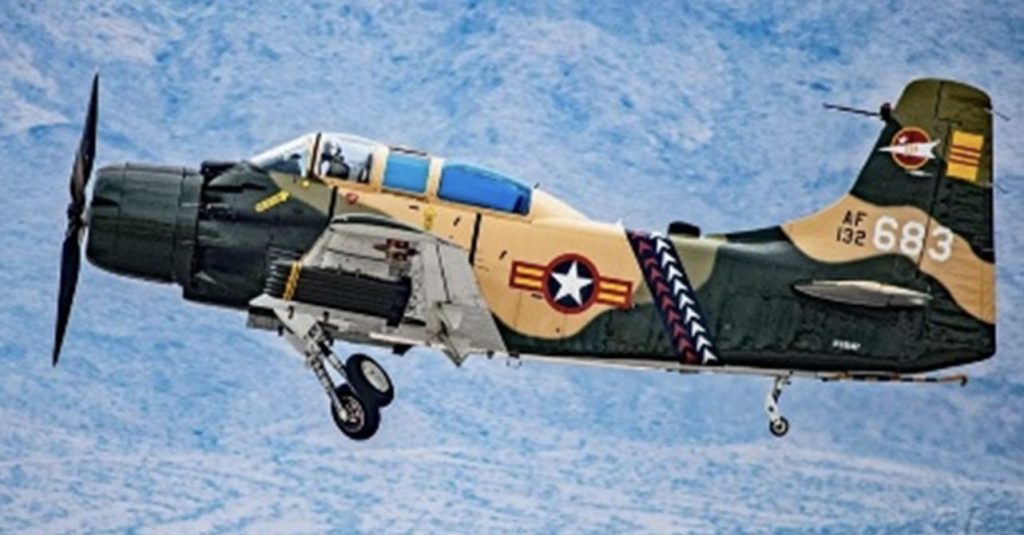
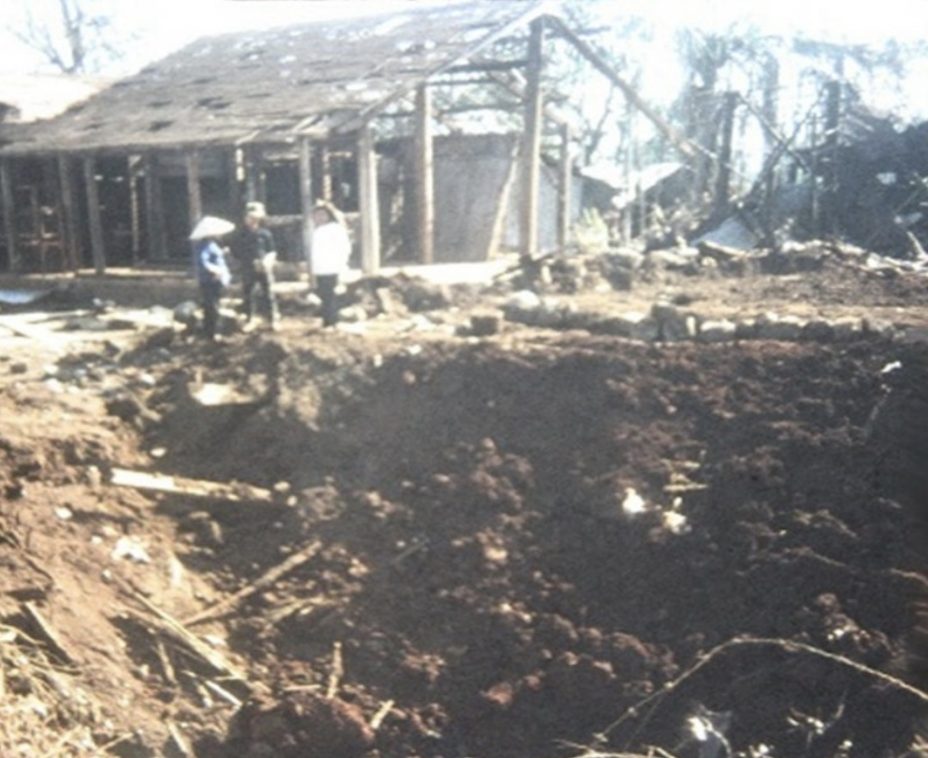
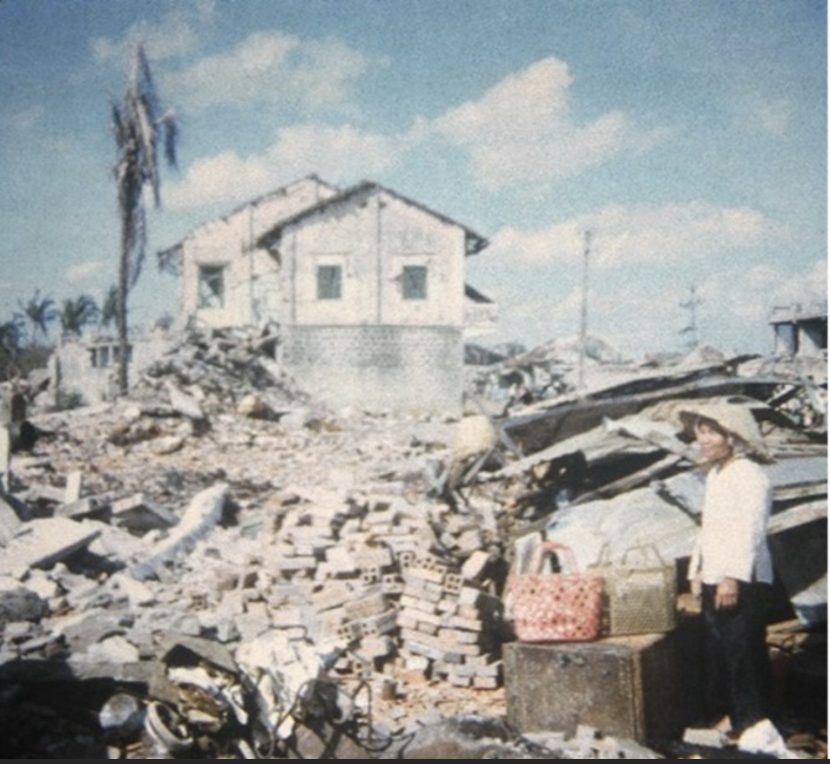
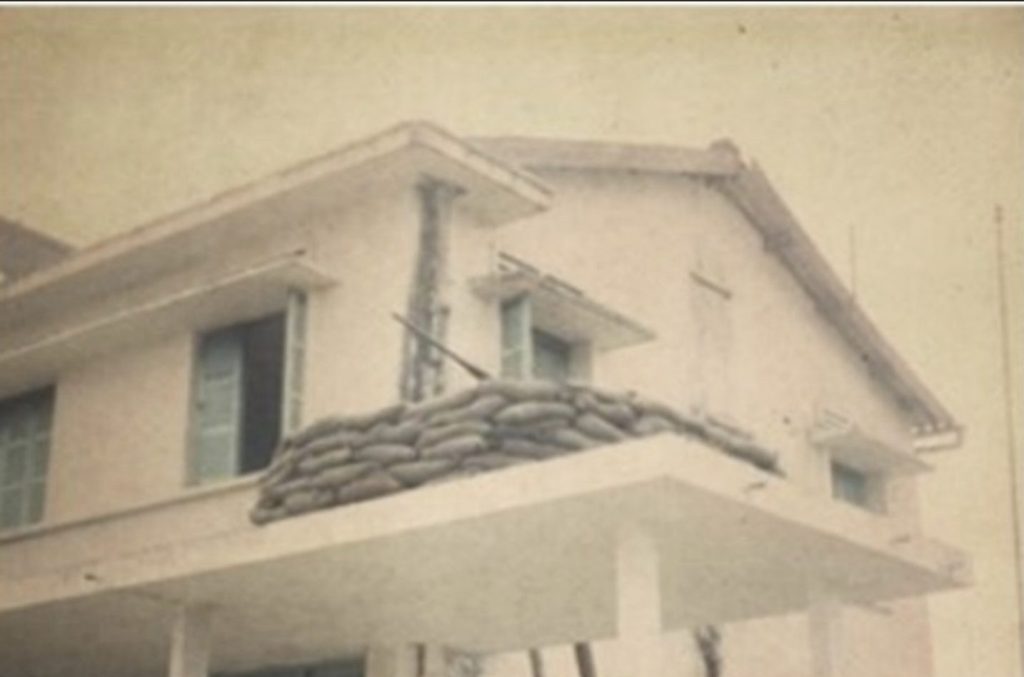
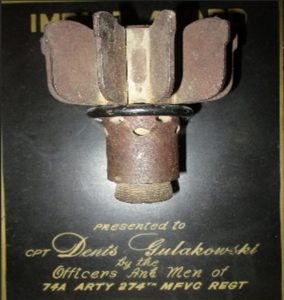
Thanks, Denny. A little different from “ rackin in the ORP”.
Definitely Pete! Although I have to admit, Ranger training was the best prep for combat in Vietnam.
Hi Dennis, thanks for your story. I’m glad the steel blast plate was between you and your award! Also, since you didn’t mention it I assume you didn’t end up with a PH for your scratches. Looking forward to seeing you next year. God bless.
Thanks for your comment Ray. That’s right, my NCO wanted to put me in for the Purple Heart, but I had to decline, since the scratches were minor. There was another captain on our province team, who was on his third tour, who had been medevaced during his second. Before all the excitement started, he and I were hanging out one day in the province compound wearing civilian shorts and T-shirts. I noticed several scars and his right calf, which looked like a shark had taken a bite – the remnants of his second tour wounds. Compared to that, mine were nothing. Definitely looking forward to seeing you next year.
Thanks, Denis, good story … and nice to have a tail fin plaque from your “friends” to remember the close call!
Thanks for your comment Eric. It’s a reminder that I was lucky to make it back; unlike my roommates Bill Pahissa and Ed Northup, and the rest of our classmates that didn’t.
Great story, Denny! Keep ’em coming.
Thanks Pete. Am working on another one even as we speak.
Great story, G!
Hard for even generals to argue with proper RTP (Radio Telephone Procedure)!
Until your next article, as Sky King would say, “Roger, wilko, over, and out!” 🙂
Best regards & BOTL,
Bill Bahr “I am Signal…Pro Patria Vigilans”
Thanks Bill. I remember Sky King – watched it as a young lad 🙂 . I haven’t thought about it many a moon. And you definitely had your finger on the classic entertainment error, “Roger, Wilco, over and out”. That so annoyed me when I would hear it. My two other pet peeves with the media are 1. The redundant “a semiautomatic handgun” and 2. The bottomless magazine, where the shooter keeps firing dozens of rounds without changing magazines. Regarding the comment to the III Corps CG, half of the ” heck” is accurate; the first two letters are not. At some point my grandchildren will be reading the story and I wouldn’t want them to see me using that language.
Great story, Denis. Good action tale, with the relief of a Hawaiin R&R thrown in. Pat and I also met in Hawaii on R&R. It was the first time she was away from our first son, who had been born just before I left for VN. We went to the Don Ho show as our special event. Earlier in the day I had embarrassed myself by going to the ticket window and asking for “…two tickets to the Don Show Ho.” That got me a bemused look from both the lady at the ticket window and Pat. I was such a smooth talker!
Jim
Thanks Jim. Coming from a best-selling author who wrote one of the best Vietnam combat books, your compliment is greatly appreciated. It was extremely interesting reading your account about the day-to-day activities of an American unit in that war. David Donovan’s book, Once a Warrior King, did a similar detailed job describing his role as an advisor out in a district. I remember thinking about the similarities between the situation in Vietnam and more recently in Afghanistan; especially the US departure.
Our Army wives do accommodate our eccentricities…
Denis —
Good story. Your trophy tale of the 82mm brought back memories. In July 1972, as Aircraft Commander Ghostrider 8, I flew a ROK Regtl Commander to a firepower demonstration at the 9th ROK Division [Peng-Ma, or White Horse] demonstration range. They had me shut the Huey down in the VIP pad, a circle of 155 cases painted white.
My crew and the RTO were sitting around the bird on the ground, passing the time as the firepower demo continued. Suddenly we heard the whisper whistle, and a Soviet 82mm mortar round struck precisely under the tailboom, AND BOUNCED.
It was a dud. Forever that image of the round, with the attached tail fins you saved, slowly rotating in the air is welded in my memory. Soviet quality control enabled five souls and 1200 lbs of jet fuel not to be incinerated on the spot.
I am now a great fan of Soviet QC, and I never again shut down inside a VIP pad.
— guy
Glad you enjoyed the story, Guy. It was fortunate that you and I survived, when a number of our classmates, to include Bill, Ed and Jerry didn’t. Especially considering the resultant outcome of that war.
Great story, Denny…with happy middle break!
Keep ‘em coming!
Glad you liked the story Rick. I’m contemplating another one that’s less harrowing and of shorter duration. We’ll see how it goes.
Take care
Thanks Denny. Great story…well told.
I loved seeing Giac Modica’s name mentioned. He was a great tac.
Glad you liked it Greg. I recall when Modica joined our team, I remembered from school that he had a hard ass reputation, and thinking ‘oh crap, how bad is it going to get?’ Turned out, he was a great guy (even though he was so satisfied with my performance, he asked me to extend). He even stopped by our place in Northern Virginia after the war when he was in the area.